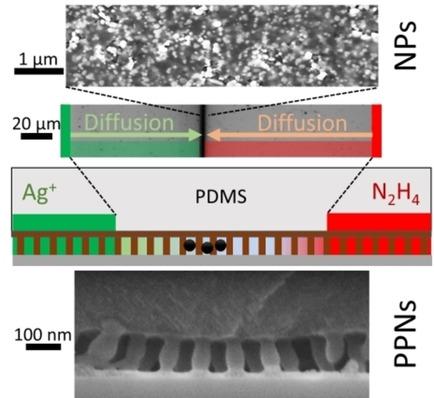当前位置:
X-MOL 学术
›
ChemNanoMat
›
论文详情
Our official English website, www.x-mol.net, welcomes your feedback! (Note: you will need to create a separate account there.)
Ionic Diffusion, Nanoparticle Formation and Trapping Within Sol‐Gel Made Pillared Planar Nanochannels in a Simple Microfluidic Device
ChemNanoMat ( IF 3.8 ) Pub Date : 2020-01-23 , DOI: 10.1002/cnma.201900654 Davide R. Ceratti 1, 2 , Marco Faustini 1 , David Grosso 1, 3
ChemNanoMat ( IF 3.8 ) Pub Date : 2020-01-23 , DOI: 10.1002/cnma.201900654 Davide R. Ceratti 1, 2 , Marco Faustini 1 , David Grosso 1, 3
Affiliation

|
Efforts to obtain widespread applications in the field of nanofluidics are increasing in intensity in recent years. However, high cost production of nanofluidic devices through the commonly used nanofabrication technologies and the incomplete understanding of solute confinement is still delaying the development of reliable, reproducible and affordable nanofluidic tools. The concentration of species and their diffusion dynamics are strongly influenced by the nanostructure architecture and surface chemistry. Testing a large number of known geometries and surface characteristics has not been possible due to limitations in fabrication procedures. Here, we try to overcome these fabrication difficulties by making the production of large scale nanofluidic devices more viable. We use an alternative bottom‐up method based on supramolecular self‐assembly and sol‐gel chemistry to produce and integrate controlled ceramic nanoporous Pillar Planar Nanochannels (PPN) within microfluidic devices. The system provides a way to easily analyze the diffusion and reaction of species in the aforementioned nanochannels. We show how to extract the nano‐confined concentration and diffusion speed without requiring any expensive analysis instrument. Subsequently, large data sets can be obtained due to the affordability of the presented nanostructure and the ease of its analysis. Moreover, since PPNs have a periodical and regular geometry the obtained data can be compared with simulations, allowing for a better description of the nanoconfined behavior of species.
中文翻译:

在简单的微流控设备中,溶胶-凝胶制成的柱状平面纳米通道中的离子扩散,纳米颗粒形成和捕集
近年来,在纳米流体领域获得广泛应用的努力正在增加。然而,通过常用的纳米制造技术高成本地生产纳米流体装置以及对溶质限制的不完全理解仍在延迟可靠,可再现和负担得起的纳米流体工具的开发。物种的浓度及其扩散动力学受到纳米结构和表面化学的强烈影响。由于制造程序的限制,无法测试大量已知的几何形状和表面特性。在这里,我们试图通过使大规模纳米流体装置的生产更可行来克服这些制造困难。我们使用一种基于超分子自组装和溶胶-凝胶化学的自下而上的替代方法,以在微流控设备中生产和集成受控的陶瓷纳米多孔柱平面纳米通道(PPN)。该系统提供了一种轻松分析上述纳米通道中物质扩散和反应的方法。我们展示了如何在不需要任何昂贵的分析仪器的情况下提取纳米级浓度和扩散速度。随后,由于所提供的纳米结构的可承受性及其分析的简便性,可以获得大量的数据集。此外,由于PPN具有周期性且规则的几何形状,因此可以将获得的数据与模拟进行比较,从而可以更好地描述物种的纳米约束行为。
更新日期:2020-01-23
中文翻译:

在简单的微流控设备中,溶胶-凝胶制成的柱状平面纳米通道中的离子扩散,纳米颗粒形成和捕集
近年来,在纳米流体领域获得广泛应用的努力正在增加。然而,通过常用的纳米制造技术高成本地生产纳米流体装置以及对溶质限制的不完全理解仍在延迟可靠,可再现和负担得起的纳米流体工具的开发。物种的浓度及其扩散动力学受到纳米结构和表面化学的强烈影响。由于制造程序的限制,无法测试大量已知的几何形状和表面特性。在这里,我们试图通过使大规模纳米流体装置的生产更可行来克服这些制造困难。我们使用一种基于超分子自组装和溶胶-凝胶化学的自下而上的替代方法,以在微流控设备中生产和集成受控的陶瓷纳米多孔柱平面纳米通道(PPN)。该系统提供了一种轻松分析上述纳米通道中物质扩散和反应的方法。我们展示了如何在不需要任何昂贵的分析仪器的情况下提取纳米级浓度和扩散速度。随后,由于所提供的纳米结构的可承受性及其分析的简便性,可以获得大量的数据集。此外,由于PPN具有周期性且规则的几何形状,因此可以将获得的数据与模拟进行比较,从而可以更好地描述物种的纳米约束行为。


























 京公网安备 11010802027423号
京公网安备 11010802027423号